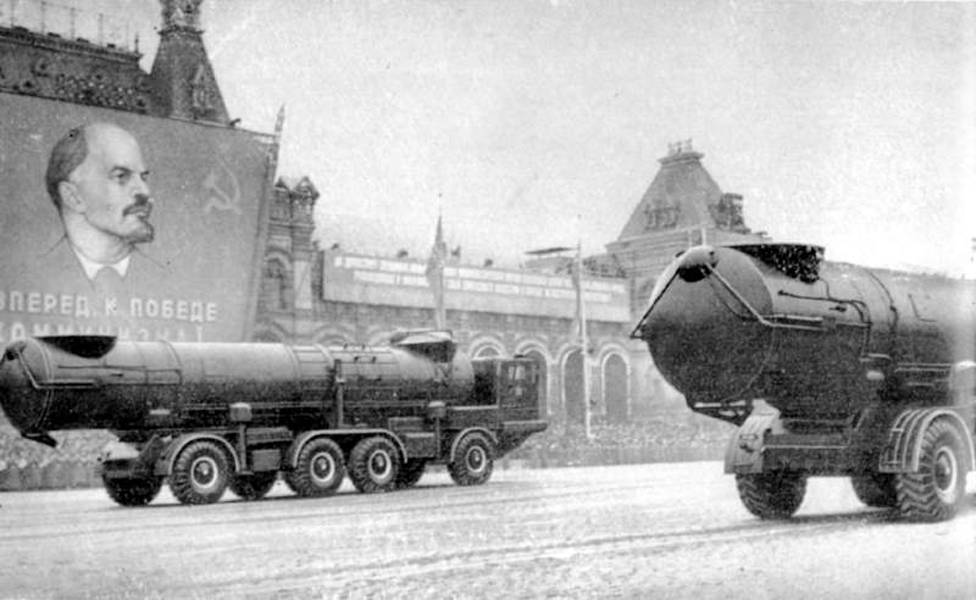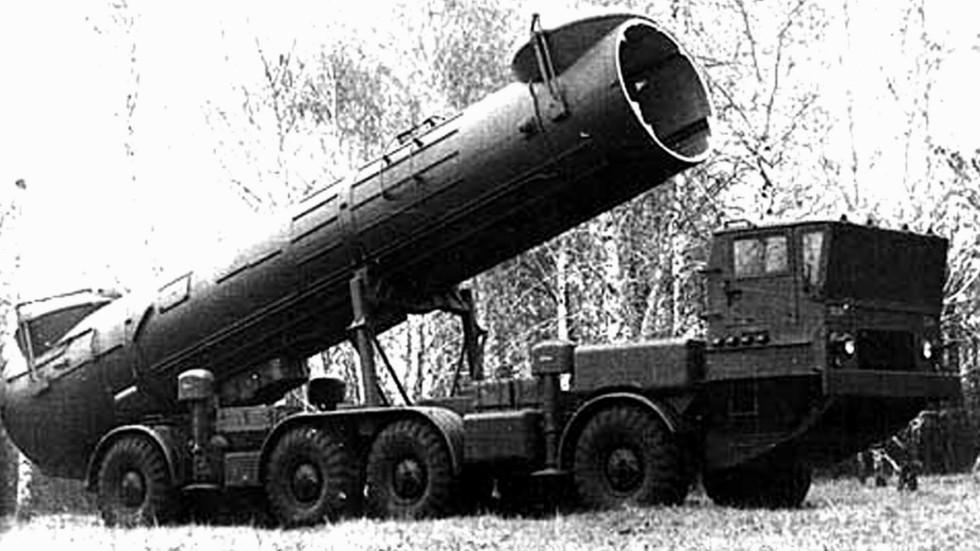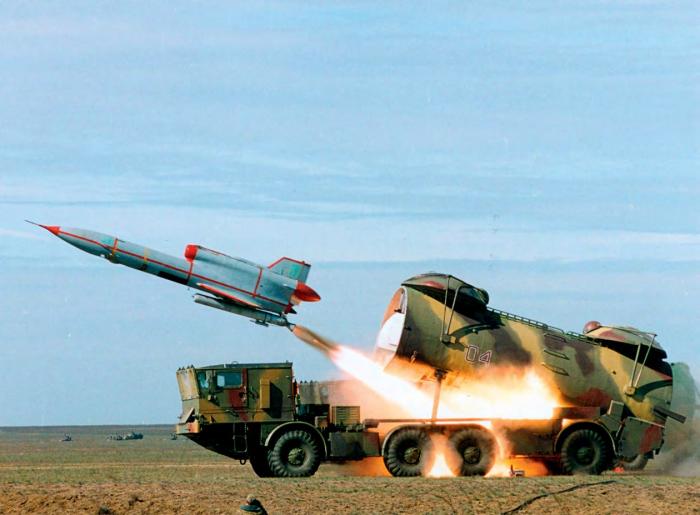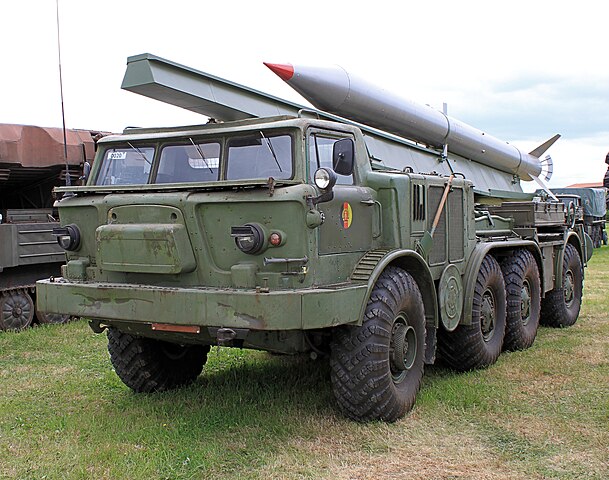ZIL-135
 Soviet Union
Soviet Union
Transport Launcher Erector Truck (1959) - c1,500 built 1959-1994
The ZIL-135 is a large eight-wheeled military transport Erector Launcher (TEL) also declined into a self-propelled artillery truck, both manufactured by ZiL on a similar chassis during the Cold War from 1959. This became the 8x8 Soviet Union prime mover and launcher platform for the Luna-M (NATO: Frog-7) surface-to-surface artillery rocket. The ZIL-135 was widely exported not only in the Warsaw Pact but also to North Korea and many other countries, seeing a lot of actions over the decades. This was also the TEL for the BM-27 Uragan system. Production was passed on to BAZ from 1963 until c1994, total numbers above 10,000 vehicles made since 1959, including foreign versions.
Development

In the late fifties the Soviet Army wanted to develop a serie of mobile heavy weapon systems on a wheeled chassis aand it was recommended to create several new models with increased capabilities, as none of the classic 6x6 or 4x6 trucks that existed at that time were suitable for ten tonnes payloads. The platform would be useful also for large hardware modules and other uses. The technical data of the vehicles being created were a function of the mass and dimensional characteristics of the equipment that was supposed to be installed on their chassis. One of the first proposals came from the Special Design Bureau of the Moscow Automobile Plant Likhachev. This was the four-axle vehicles ZIL-135. The prototypes were unique, designed as super-lightweight machines capable of a 1/1 payload ratio and devoid (at first) of suspensions.
Following the failure of the 939/931 series, Bryansk shifted to production of a simplified version of the ZiL-135. Initially, the ZIL-135 was developed as a tractor for towing cannon artillery at the ZIL Special Design Bureau under the leadership of V. A. Grachev in the early 1950s. He was seconded by Designer Vitaly Andreevich and the Manufacturer was Likhachev Plant. It was accepted for service and production started in 1959. It went on until 1963 with ZIL and then from there to 1994-95 with BAZ. Upgraded versions appeared over the years, the latter being the BM.
The vehicle was equipped with two ZIL-123F engines with a power of 120 hp each installed behind the cab, but the following models would use the ZIL-375 engine. Each was responsible for its own side's wheels, for survivability. Due to the use of low-pressure tires, and to reduce height weight as much as possible, designers decided to abandon the suspension. It was a first. Instead, Vitaly Grachev wanted a chassis "galloping on a multi-axle system". The whole rationale behind it was that the load could be placed heavier and higher and counterbalancing a higher center of gravity.
 ZIL 135K on the red square parade. src denisovets.ru
ZIL 135K on the red square parade. src denisovets.ru
However this was later reverted. On the ZIL-135E, due to the absence of suspensions started to rattle ans suffer from resonance vibrations at a speed of 15-20 kph already on a dirt road. And it was supposed to be an off-road truck. During the same test, the driver pushed nevertheless to 60 km/h until vibrations were enough to made him loose control, not counting damage to the engines and mechanical parts. This was partially corrected with the next ZIL-135K featuring a reverse sloped windshield to avoid sun reflections, an elongated wheelbase. This revised vehicle had a distance between steering axles of 7,3 meters, but still run without suspension. It was quieter at 15-20 kph thanks to this large base but issues started when reaching 60 kph, so engineers went around the issue by placing a mechanical speed limiter.
This ZIL 135K was no different than the early serie, with a front and rear pair of steerable axle and two ZIL-375Ya gasoline engines plus a non-differential transmission, with an independent drive either side. So save weight it had at first a plastic cab derived from the ZIL 135E series, but also three all plastic three-seat configuration and still the same two pillars, three wipers, down-sloped windshield to counter early or late daylight glare. The ZIL-135K was setup to carry the S-5 cruise missile developed by the Chelomey Design Bureau. For it was designed a 12-meter container. It was not fully erected and launched forward. What was groundbreaking and really rewarding for the engineers was the fact this truck could carry more than its weight, a payload of 10,500 kg for its curb weight being 10,5 tons. In the Typical Russian harsh operating conditions this was not a luxury. In winter for example, ice tended to buildup atop of the payload, sometimes adding a ton or more while underway, when raining or snowing...
 ZIL 135K with the launcher semi-erected for launching.
ZIL 135K with the launcher semi-erected for launching.
This 2P30 complex comprising the new Grachev truck and Chelomey rocket entered service on December 30, 1960. Only five were made at ZIL before being passed onto Bryansk Automobile Plant (BAZ) which made another 80. They also retook the typical reverse sloped windshield and angular cab for their future trucks. Meanwhile work went on a modernized vehicle at ZIL, studied by SKB, which planned to install the anti-ship missile Redut on the 135K. This time, given the shorter missile, it was possible to create a larger crew compartment behind the main cab in order to house all the complex's crew.
 BAZ-135MBK (ZIL 135K) SPU-143 Redut. src SERGEI POPSUEVICH via keymil.
BAZ-135MBK (ZIL 135K) SPU-143 Redut. src SERGEI POPSUEVICH via keymil.
It was done and after successful prototype tests, enginneers still decided to improve the 135K, fitting a single YaMZ-238 diesel engine rated for 300 hp coupled with a single gearbox and inter-board differential gearbox for drive and torque distribution on either side. This ended as the BAZ-135MV. It was produced by BAZ. Later the latter also produced the BAZ-135MB from 1976 carrying and operating the tactical "Reis" jet drone Tu-143.
The team also tested a model which had an electric transmission. There were two main generators and eight electric motors, one for each wheel. This arrangement for the mid-60s was revolutionary. Each electric motor transmitted torque to its own wheel through a two-stage planetary gearbox. The prototype also had a torsion bar suspension kit for both its steering axles for testing, but it was abandoned and instead the conventional rigid suspension was kept. With the torsion bar suspension the payload could be elevated to 11,5 tons versus 8,6 tons due to the heavy electric transmission. It was also called ZIL-135E but not produced.
| Type | ZIL-135LM | ZIL-135MB |
| Configuration/chassis | 8x8 | 8x8 |
| Gross weight | 9 tons | 9.8 tons |
| Payload | 10.5 tons | <11.5 tons |
| Full mass | Unknown | 21.4 tons |
| Top speed | 70 kph | 60 kph |
| Dimensions | 9,27 x 2,80 x 2,53 m | 9,27 x 2,80 x 2,53 m |
| Ground clearance | 58 cm | 58 cm |
| Track | 2,30 meters | 2,30 meters |
| Wheelbase | 6.30 meters | 6.30 meters |
| Powerplant | V8 7 liters Gas. 2 carburetors, liquid cooling | V8 Diesel, same. |
| Output | 2x 175 ho at 3200 rpm | 300 hp |
Evolution towards the "familiar" ZIL-135

And then came a new vehicle, at least in appareance (which was more flattering), and best in the serie. The ZIL 135L and LM. On all 135L/LM, to avoid longitudinal swaying that plagued early series of the 135 family, it was decided to return to independent torsion bar suspension, with hydraulic shock absorbers also applied to the outer axles and maintain a rigid attachment to the frame and middle axles. Only the wheels of the outer axles are steered, but dimensions, load capacity or suspension design, bouyancy and amphibious capabilities as well as the wheelbase varied widely from one model to another. Until 1993 more than 1,000 were manufactured, by far the largest contingent.
General Design

This ZIL-135 has two gasoline engines which allowed this 20 tonnes behemoth to reach 65 kilometres per hour (40 mph) loaded on road. One engine was used to power the four left wheels, and the other to the right. This it was a true 8x8 or eight wheel drive, with steering applied only to the front and rear axles. Maximum cruising range was about 500 kilometres (310 mi). The vehicle was not armoured but had a fiberglass cab for sparing weight and increase load capacity, which was NBC protected, so the crew can launch its payload while renmaining inside, into a sealed compartment. The six-man crew was generally able to proceed to the launch from stopping to launching and on the road again in three minutes, less than the flying time of its payload.
The vehicle had an overall Weight 12,500 kg and a load capacity of 6 up to 8 tons on highway, 15 tonnes afloat or to carry 22 men. It was not compatible with tactical medium transport aircraft such as the Ll-76, being 3,30 meters wide and 3,10 meters high. Its ground clearance was 580 mm. The ZIL-135 V8 gasoline ZIL-375YA engines had carburetor for a total outout of 360 hp (264.6 kW) and a fuel tank capacity 560 liters. Depending of the versions, some were light enough to swim, at a water speed of 18 km/h. It could also climb a 31° slope.
 BAZ 135MB at Patriot Park
BAZ 135MB at Patriot Park
 ZIL 135L
ZIL 135L
ZIL-135L and BAV 135L4 truck

Standard 10 ton cargo variant, with a flatbed about 6/10 of its lenght, with non folding side panels and folding back panel. They were composed of a lower all metal bucket part above the flatbed and the usual add-on wooden/metal barriers. It could receive up to 10 tonne of payload on paper but in reality, these trucks were overloaded and 12-15 tonnes payload were not unusual. This was the baseline cargo version, with a troop capacity (nominal) of 22 men in two double end bunks rows but it could be more.
To come: 9K52 complex, Luna-M (Frog-7) TEL

(Future update)
Variants
 ZIL-135P "dolphin" (1965)
ZIL-135P "dolphin" (1965)
- ZIL-135 (9P113): 9K52 Luna-M TEL (1959)
- ZIL-135R (9T29): Luna-M reloader truck (1959)
- ZIL-135B: Amphibious version of ZIL-135 (1959)
- ZIL-135E: Non-amphibious version of ZIL-135B (1960)
- ZIL-135L: Improved suspension (1961), used as standard truck
- ZIL-135LM: ZIL-135L with manual transmission (1963), production transferred to BAZ
- ZIL-135K: C-5 missile TEL (1961), based on ZIL-135E, to BAZ 1962
- ZIL-135Eh: Diesel-electric transmission (1965)
- ZIL-135KM: P-5 Pyatyorka TEL (NATO: SS-N-3 Shaddock) to BAZ 1962
- ZIL-135KP: land train (1969)
- ZIL-135LN: Chassis-cab borrowed from ZIL-135K
- ZIL-135P: amphibious landing transport (landing barge, 1965)
- ZIL-135SH: Prototype zero-turn radius version.*
*Two ZIL-375Ya V8 engines, powering a generator to turn front struts from an Il-18 and rear axle from a ZIL-130.
- ZIL-135K: 9P113 TEL for FCR-2 rocket (1961)
- BAZ-135LM: 9P113 TEL with manual transmission (1963-1994)
- BAZ-135LMT (BAZ-135L7): Tropicalized BAZ-135LM for export (1968)
- BAZ-135LMP: BM-27 Uragan MLRS weapon system (GRAU 9P140) (1976)
- ZIL-135LMR 9T422 BM-27 reloader truck (1976)
- BAZ-135LTM: 9P113 TEL for 9M21 Luna-M missile (9K52 system) (1963)
- BAZ-135L4: Civilian truck (1968)
- BAZ-E135G: Experimental prototype with gas turbine engine
- BAZ-135M1: Single diesel engine prototype
- BAZ-135MB: SPU-35V system for the Tu-143 and Tu-243 jet drones (1964)
- BAZ-135MBP: Metal cargo flatbed
- BAZ-135MBK: Increased cargo and towing capacity (1991)
- BAZ-135MBL: (1993)
Operators
| Generric specs ZIL-135LM |
| Dimensions: | 9,260 x 3,130 x 3,060 mm (364.6 in x 123.2 in x 120.5 in) |
| Curb weight: | 7,000 kg (15,432 lb) |
| Tires: | Not precised |
| Crew: | 2+ variant based, see notes |
| Propulsion: | 6.9 L ZIL-375YA V8 ×2* |
| Transmission: | 2x 6-speed automatic, or 2x 5-speed manual (135LM) |
| Speed: | 65+ kph |
| Range (road/off road): | 500 km+ variant dependent |
| Payload: | 10 tons nominal, 12t and more. |
| Production: | c10,000 1959-1994 |
*Prototype: 2x 5.6 L ZIL-123F I6 ×2
Sources